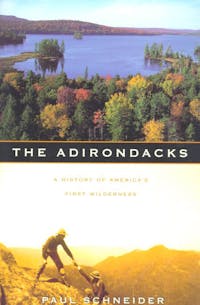The Adirondacks
A History of America's First Wilderness
 Download image
Download image
ISBN10: 0805059903
ISBN13: 9780805059908
Trade Paperback
384 Pages
$23.99
CA$31.99
A New York Times Notable Book
In this insightful ecological, social, and scientific history of the Adirondacks, Paul Schneider exposes the love affair between Americans and the region while continuing the debate about how to keep the Adirondacks "wild forever," which was mandated in 1885 by the New York legislature. From its earliest inhabitants (Haudenosaunce/Iroquois) to the infamous John Brown to President Theodore Roosevelt, the Adirondacks has been known as a place of opportunity. A place where trappers nearly dried the area of furs, loggers logged and miners prospected mightily. "With this long progression of users and abusers of the wilderness, is it possible to even consider the area wild or hope that it will be again? Schneider details some of the efforts of concerned volunteer groups and paid government officials who have worked over the years to this end and have arrived at different answers to that question." (Booklist).
Reviews
Praise for The Adirondacks
"A biography of a place, a life of the Adirondacks . . . Immensely satisfying . . . His book is a roughly chronological, swiftly readable account of Indians and trappers, redcoats, hermits, magnates, reprobates and esthetes. It also drops interesting names . . . John Brown, J. P. Morgan, William James, Maxim Gorky—to pick a few . . . The park's story comes to life in his hands. For one thing, he has an eye for detail . . . And he has peopled his history with one remarkable character after another, quickly and deftly drawn . . . The countless facts are irresistible."—James Gorman, The New York Times Book Review
"Absolutely fascinating. Paul Schneider conjures the Adirondack wilderness as a vast and imposing stage on which a succession of human dramas—from the romantic to the terrifying—come alive in stark and immensely readable detail."—John Berendt, author of Midnight in the Garden of Good and Evil
"What is particularly distinctive about Schneider's book is the sense of place he conveys, a descriptive gift that adds weight to his treatment of the long struggle to keep the Adirondacks wild—or as wild as a couple of centuries of human enterprise and interference will allow. The character of the landscape—the very quality that drives those who love the place and would save it—informs Schneider's narrative throughout the book."—T. H. Watkins, Preservation
"The Adirondack stories are intriguing and Schneider tells them well . . . succinctly and engagingly . . . A sign of a very good book is that as soon as it's read you want to read it again, and that is just how I feel."—Bob Worth, president, Adirondack Museum
"Journalist Schneider has written a poignant, insightful history of New York State's Adirondack region. He relates here the life and lore of these scenic mountains and lakes (Whiteface, Mt. Marcy, Fulton Chain Lakes) from the region's earliest inhabitants (Haudenosaunce/Iroquois) through the advent of Henry Hudson (1609), the Revolutionary War, abolitionists (John Brown), 19th-century homesteaders, Hudson River School artists, tuberculosis patients to Melville Dewey's Lake Placid Club, the Adirondack Mountain Club, and the present environmental conservation efforts. Schneider duly records that this once wild and untamed region has accommodated the likes of Wil Durant, Paul Smith, Robert Louis Stevenson, James Fenimore Cooper, Sigmund Freud, Carl Jung, and Presidents B. Harrison, Coolidge, Hoover, and T. Roosevelt. It is now up to our present legislators, he notes, to preserve what remains."—Library Journal
"A crisp, filigreed history of the Adirondacks . . . What makes Schneider's book distinctive is that he not only quarries these obvious attention-grabbers, but as well does a neat job of explicating the more mundane matters of the park, in particular the sometimes peaceful co-existence, sometimes dysfunctional marriage between private and public notions of the future of the parkland. For a slice of real estate that doesn't suffer from literary neglect, Schneider's contribution is a welcome, lively, and ranging consideration."—Kirkus Reviews



